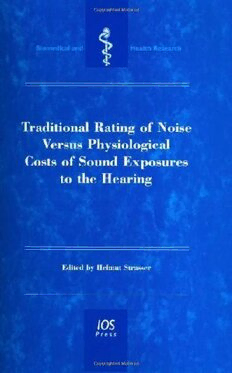Download Traditional Rating of Noise Versus Physiological Costs of Sound Exposures to the Hearing (Biomedical and Health Research) PDF Free - Full Version
Download Traditional Rating of Noise Versus Physiological Costs of Sound Exposures to the Hearing (Biomedical and Health Research) by H. Strasser in PDF format completely FREE. No registration required, no payment needed. Get instant access to this valuable resource on PDFdrive.to!
About Traditional Rating of Noise Versus Physiological Costs of Sound Exposures to the Hearing (Biomedical and Health Research)
In occupational safety and health acts, ordinances, regulations, directives, standards and guidelines, A-weighted sound exposures, varying in level and duration, are traditionally converted to an 8-hour-average sound level by applying the 3-dB exchange rate. Under the prerequisite that the energy equivalent rating level does not exceed 85 dB(A)/8 h, even impulse noise exposures of up to 140 dB are declared harmless. Indeed, the mutual settlement of level and duration based on the concept of energy equivalence is correct as far as sound energy or physical dose is concerned. However, between this principle and work physiological and work psychological, i.e. ergonomics paradigms, some decisive discrepancies do exist, and the dose maxim cannot be accepted from an ergonomics point of view. People react to exposures according to human characteristics rather than 'function' according to the laws of physics as they apply to inert matter. This has been demonstrated by a series of new experimental approaches, in which temporary threshold shifts and their restitution associated with various energy equivalent noise exposures have been measured. Also the impact of various types of loud music has been investigated. In addition to the conventionally determined maximum threshold shift, TTS2, and the time it takes to reach the resting hearing level again, the area under the restitution curve, i.e. the integrated restitution temporary threshold shifts, indicate the total physiological costs the hearing has to pay for a preceding sound exposure. Quite different statistically significant physiological responses to equally rated and legally tolerated sound exposures (94 dB(A)/1 h / 85 dB(A)/8 h) have repeatedly been measured. These refute the concept of energy-equivalence along virtually all dimensions, for example, substantially underestimating the risk of impulse noise, legalizing the 'filling' of resting periods with noise, ignoring the fact that short-term, high continuous noise is even quite favourable for the hearing, or prognosticating drastic losses in attenuation after short time periods of not wearing hearing protective devices, making them sound worse than they are. This book is an attempt to increase the transparency in existing evaluation methods and - in the interest of pertinent disclosure of risks associated with common procedures - to work towards the elimination of unacceptable simplifications and dangerously erroneous assessments.IOS Press is an international science, technical and medical publisher of high-quality books for academics, scientists, and professionals in all fields. Some of the areas we publish in: -Biomedicine -Oncology -Artificial intelligence -Databases and information systems -Maritime engineering -Nanotechnology -Geoengineering -All aspects of physics -E-governance -E-commerce -The knowledge economy -Urban studies -Arms control -Understanding and responding to terrorism -Medical informatics -Computer Sciences
Detailed Information
| Author: | H. Strasser |
|---|---|
| Publication Year: | 2005 |
| ISBN: | 9781429467605 |
| Pages: | 240 |
| Language: | English |
| File Size: | 5.679 |
| Format: | |
| Price: | FREE |
Safe & Secure Download - No registration required
Why Choose PDFdrive for Your Free Traditional Rating of Noise Versus Physiological Costs of Sound Exposures to the Hearing (Biomedical and Health Research) Download?
- 100% Free: No hidden fees or subscriptions required for one book every day.
- No Registration: Immediate access is available without creating accounts for one book every day.
- Safe and Secure: Clean downloads without malware or viruses
- Multiple Formats: PDF, MOBI, Mpub,... optimized for all devices
- Educational Resource: Supporting knowledge sharing and learning
Frequently Asked Questions
Is it really free to download Traditional Rating of Noise Versus Physiological Costs of Sound Exposures to the Hearing (Biomedical and Health Research) PDF?
Yes, on https://PDFdrive.to you can download Traditional Rating of Noise Versus Physiological Costs of Sound Exposures to the Hearing (Biomedical and Health Research) by H. Strasser completely free. We don't require any payment, subscription, or registration to access this PDF file. For 3 books every day.
How can I read Traditional Rating of Noise Versus Physiological Costs of Sound Exposures to the Hearing (Biomedical and Health Research) on my mobile device?
After downloading Traditional Rating of Noise Versus Physiological Costs of Sound Exposures to the Hearing (Biomedical and Health Research) PDF, you can open it with any PDF reader app on your phone or tablet. We recommend using Adobe Acrobat Reader, Apple Books, or Google Play Books for the best reading experience.
Is this the full version of Traditional Rating of Noise Versus Physiological Costs of Sound Exposures to the Hearing (Biomedical and Health Research)?
Yes, this is the complete PDF version of Traditional Rating of Noise Versus Physiological Costs of Sound Exposures to the Hearing (Biomedical and Health Research) by H. Strasser. You will be able to read the entire content as in the printed version without missing any pages.
Is it legal to download Traditional Rating of Noise Versus Physiological Costs of Sound Exposures to the Hearing (Biomedical and Health Research) PDF for free?
https://PDFdrive.to provides links to free educational resources available online. We do not store any files on our servers. Please be aware of copyright laws in your country before downloading.
The materials shared are intended for research, educational, and personal use in accordance with fair use principles.

